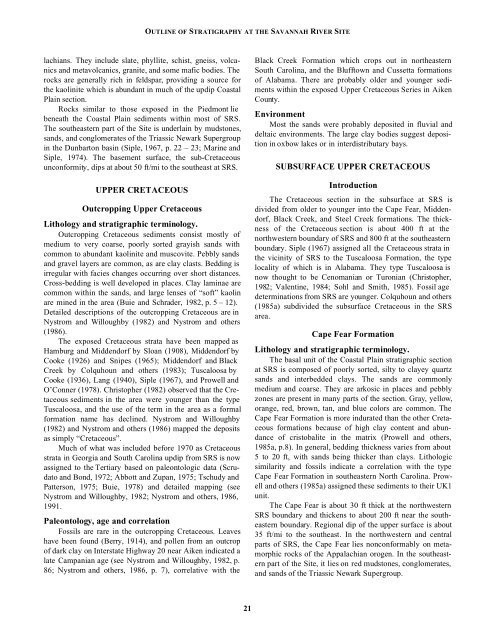Download Guidebook as .pdf (1.8 Mb) - Carolina Geological Society
Download Guidebook as .pdf (1.8 Mb) - Carolina Geological Society
Download Guidebook as .pdf (1.8 Mb) - Carolina Geological Society
You also want an ePaper? Increase the reach of your titles
YUMPU automatically turns print PDFs into web optimized ePapers that Google loves.
OUTLINE OF STRATIGRAPHY AT THE SAVANNAH RIVER SITE<br />
lachians. They include slate, phyllite, schist, gneiss, volcanics<br />
and metavolcanics, granite, and some mafic bodies. The<br />
rocks are generally rich in feldspar, providing a source for<br />
the kaolinite which is abundant in much of the updip Co<strong>as</strong>tal<br />
Plain section.<br />
Rocks similar to those exposed in the Piedmont lie<br />
beneath the Co<strong>as</strong>tal Plain sediments within most of SRS.<br />
The southe<strong>as</strong>tern part of the Site is underlain by mudstones,<br />
sands, and conglomerates of the Tri<strong>as</strong>sic Newark Supergroup<br />
in the Dunbarton b<strong>as</strong>in (Siple, 1967, p. 22 – 23; Marine and<br />
Siple, 1974). The b<strong>as</strong>ement surface, the sub-Cretaceous<br />
unconformity, dips at about 50 ft/mi to the southe<strong>as</strong>t at SRS.<br />
UPPER CRETACEOUS<br />
Outcropping Upper Cretaceous<br />
Lithology and stratigraphic terminology.<br />
Outcropping Cretaceous sediments consist mostly of<br />
medium to very coarse, poorly sorted grayish sands with<br />
common to abundant kaolinite and muscovite. Pebbly sands<br />
and gravel layers are common, <strong>as</strong> are clay cl<strong>as</strong>ts. Bedding is<br />
irregular with facies changes occurring over short distances.<br />
Cross-bedding is well developed in places. Clay laminae are<br />
common within the sands, and large lenses of “soft” kaolin<br />
are mined in the area (Buie and Schrader, 1982, p. 5 – 12).<br />
Detailed descriptions of the outcropping Cretaceous are in<br />
Nystrom and Willoughby (1982) and Nystrom and others<br />
(1986).<br />
The exposed Cretaceous strata have been mapped <strong>as</strong><br />
Hamburg and Middendorf by Sloan (1908), Middendorf by<br />
Cooke (1926) and Snipes (1965); Middendorf and Black<br />
Creek by Colquhoun and others (1983); Tuscaloosa by<br />
Cooke (1936), Lang (1940), Siple (1967), and Prowell and<br />
O’Conner (1978). Christopher (1982) observed that the Cretaceous<br />
sediments in the area were younger than the type<br />
Tuscaloosa, and the use of the term in the area <strong>as</strong> a formal<br />
formation name h<strong>as</strong> declined. Nystrom and Willoughby<br />
(1982) and Nystrom and others (1986) mapped the deposits<br />
<strong>as</strong> simply “Cretaceous”.<br />
Much of what w<strong>as</strong> included before 1970 <strong>as</strong> Cretaceous<br />
strata in Georgia and South <strong>Carolina</strong> updip from SRS is now<br />
<strong>as</strong>signed to the Tertiary b<strong>as</strong>ed on paleontologic data (Scrudato<br />
and Bond, 1972; Abbott and Zupan, 1975; Tschudy and<br />
Patterson, 1975; Buie, 1978) and detailed mapping (see<br />
Nystrom and Willoughby, 1982; Nystrom and others, 1986,<br />
1991.<br />
Paleontology, age and correlation<br />
Fossils are rare in the outcropping Cretaceous. Leaves<br />
have been found (Berry, 1914), and pollen from an outcrop<br />
of dark clay on Interstate Highway 20 near Aiken indicated a<br />
late Campanian age (see Nystrom and Willoughby, 1982, p.<br />
86; Nystrom and others, 1986, p. 7), correlative with the<br />
Black Creek Formation which crops out in northe<strong>as</strong>tern<br />
South <strong>Carolina</strong>, and the Blufftown and Cussetta formations<br />
of Alabama. There are probably older and younger sediments<br />
within the exposed Upper Cretaceous Series in Aiken<br />
County.<br />
Environment<br />
Most the sands were probably deposited in fluvial and<br />
deltaic environments. The large clay bodies suggest deposition<br />
in oxbow lakes or in interdistributary bays.<br />
SUBSURFACE UPPER CRETACEOUS<br />
Introduction<br />
The Cretaceous section in the subsurface at SRS is<br />
divided from older to younger into the Cape Fear, Middendorf,<br />
Black Creek, and Steel Creek formations. The thickness<br />
of the Cretaceous section is about 400 ft at the<br />
northwestern boundary of SRS and 800 ft at the southe<strong>as</strong>tern<br />
boundary. Siple (1967) <strong>as</strong>signed all the Cretaceous strata in<br />
the vicinity of SRS to the Tuscaloosa Formation, the type<br />
locality of which is in Alabama. They type Tuscaloosa is<br />
now thought to be Cenomanian or Turonian (Christopher,<br />
1982; Valentine, 1984; Sohl and Smith, 1985). Fossil age<br />
determinations from SRS are younger. Colquhoun and others<br />
(1985a) subdivided the subsurface Cretaceous in the SRS<br />
area.<br />
Cape Fear Formation<br />
Lithology and stratigraphic terminology.<br />
The b<strong>as</strong>al unit of the Co<strong>as</strong>tal Plain stratigraphic section<br />
at SRS is composed of poorly sorted, silty to clayey quartz<br />
sands and interbedded clays. The sands are commonly<br />
medium and coarse. They are arkosic in places and pebbly<br />
zones are present in many parts of the section. Gray, yellow,<br />
orange, red, brown, tan, and blue colors are common. The<br />
Cape Fear Formation is more indurated than the other Cretaceous<br />
formations because of high clay content and abundance<br />
of cristobalite in the matrix (Prowell and others,<br />
1985a, p.8). In general, bedding thickness varies from about<br />
5 to 20 ft, with sands being thicker than clays. Lithologic<br />
similarity and fossils indicate a correlation with the type<br />
Cape Fear Formation in southe<strong>as</strong>tern North <strong>Carolina</strong>. Prowell<br />
and others (1985a) <strong>as</strong>signed these sediments to their UK1<br />
unit.<br />
The Cape Fear is about 30 ft thick at the northwestern<br />
SRS boundary and thickens to about 200 ft near the southe<strong>as</strong>tern<br />
boundary. Regional dip of the upper surface is about<br />
35 ft/mi to the southe<strong>as</strong>t. In the northwestern and central<br />
parts of SRS, the Cape Fear lies nonconformably on metamorphic<br />
rocks of the Appalachian orogen. In the southe<strong>as</strong>tern<br />
part of the Site, it lies on red mudstones, conglomerates,<br />
and sands of the Tri<strong>as</strong>sic Newark Supergroup.<br />
21













